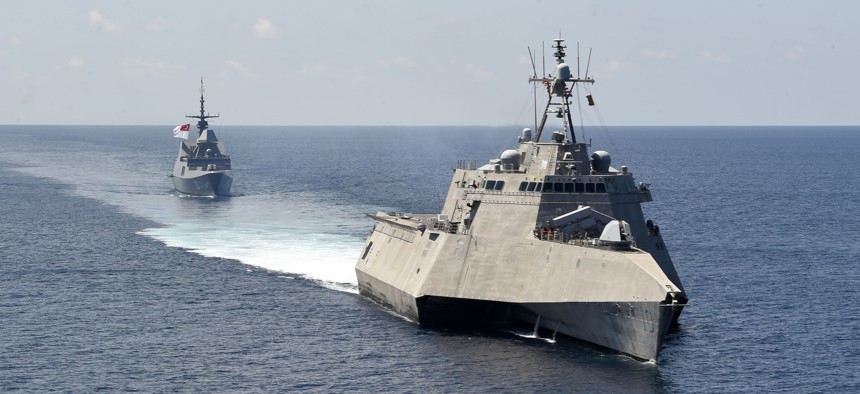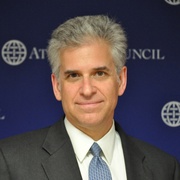
The Independence-variant littoral combat ship USS Gabrielle Giffords (LCS 10), front, exercises with the Republic of Singapore navy Formidable-class multi-role stealth frigate RSS Steadfast (FFS 70) in the South China Sea, May 25, 2020. U.S. Navy / Mass Communication Specialist 2nd Class Brenton Poyser
The Coronavirus Is Raising the Likelihood of Great-Power Conflict
U.S. efforts to increase deterrence must be carefully calibrated to avoid accidental escalation.
Over the last few weeks, Chinese and American military operations in the western Pacific have been increasing in intensity and show little signs of abating.
U.S. armed forces are finally moving – in a big way – to restore deterrence against China in the western Pacific Ocean. News of a substantial proportion of the Navy’s 11 aircraft carriers, along with submarines from the Pacific fleet, surging to the western Pacific Ocean, should go far toward countering any misperceptions by the Chinese military that U.S. force readiness is diminished due to the pandemic.
Indeed, Chinese actions over the last month and a half have been particularly aggressive, and the PLA Navy’s recent military operations follow years of other coercive measures that featured permanent Chinese military facilities being built on islands in disputed international waters and a wide range of other aggressive activities against regional navies.
Back in early April, reports of the coronavirus spreading among the U.S. Navy in the Pacific began to increase. Particularly upon hearing the news of the U.S. aircraft carrier Theodore Roosevelt pulling into Guam with exploding numbers of coronavirus cases—and with the U.S. government preoccupied with the extensive domestic responses to the coronavirus outbreaks nationwide —I immediately became worried that the Chinese would misperceive this moment as a chance to coerce Taiwan militarily into unification with the communist mainland.
As a former Special Assistant to the President and Senior Director for Defense Policy and Strategy on the National Security Council staff, I would have advised any President to seek to preclude such a dangerous scenario by taking measures to send the necessary message to friend and foe alike. That message should be clear, to include the following:
• The entire world is fighting this coronavirus outbreak on all fronts.
• The U.S. is currently on the front lines, using all elements of national power to limit the number of deaths and flatten the curve.
• The U.S. Navy is not immune to suffering from this outbreak.
• However, we are as ready as we have ever been, and if any nation were so foolish as to seek to coerce or attack an ally or partner of the United States at this time of crisis, then that nation would suffer military and other consequences that would be vastly disproportionate to any gains they would seek.
• Thus, we are hereby increasing our forces’ operational tempo and military readiness to ensure that no potential adversary mistakes the current moment for one of U.S. military weakness. We also are now surging a wide range of combat aircraft as well as ships from our global naval fleet to the western Pacific. This greatly heightened set of force enhancements in the region should not only serve to deter China from action against the United States, but also give the PLA Navy great pause regarding any further considerations of aggressive actions against regional U.S. allies and partners.
Such statements, underwritten by military force deployments, would assure Pacific allies and help deter Chinese military adventurism. Now that such U.S. military actions are underway, the probability of any Chinese military miscalculations should be reduced.
However, military moves beget countermoves, and the Chinese military is unlikely to sit still in the face of such a display of U.S. military might in its neighborhood. Rather, the PLA is likely to spin up its own forces and increase the intensity of its own military operations in response. These forces will heighten their own operations in the western Pacific as well.
The result very well could be that U.S. and Chinese forces begin operating at much higher intensity near each other, and the major worry in such a scenario would be greatly heightened chances of an accident or an incident. This is especially likely if Chinese naval forces continue their pattern of aggressive and unprofessional maritime maneuvers near U.S. naval forces.
Thus, while the move to buttress U.S. deterrence was long overdue and sorely needed in order to begin to push the aggressive Chinese military back, the chances of accidental conflict now will be increased. This is a better overall outcome than what the previous trends were leading to: a fully Chinese-dominated region. Nonetheless, particularly in the context of increasing talk of a new Cold War on both sides of the most important bilateral relationship in the world, it means that the possibility of a U.S.-China military conflict is greater. Thus, U.S. officials will have to carefully calibrate the surge to get the job done while not eliciting an overreaction that could slip into all-out conflict.
Stepping back, if the pandemic itself can be considered the greatest strategic shock to geopolitics since World War II, then the secondary shocks that it generates – including an economic downturn that could lead to a great depression –could be equally significant and unpredictable in their impacts. The increased probability of a U.S.-China military confrontation is one such potential secondary shock.
Finally, U.S. forces’ engagement in the INDOPACOM theater means fewer forces to sustain deterrence elsewhere. And here, Russia is a major wild card. Russian President Vladimir Putin’s power base is being increasingly rattled by not just historically low energy prices, but also the wildfire-like spreading of coronavirus in Russia right now. One could not rule out the possibility that Putin might use an external military adventure in Europe or elsewhere to distract from his domestic failures and from Russia’s failing economy in order to try to shore up his power base. And there would be no better time than when U.S. forces are highly engaged in the Pacific for Russian military forces to conduct aggressive operations in northeastern Europe. The potential for this sort of opportunistic aggression against NATO and U.S. interests in Europe will be heightened while this unfortunate confluence of circumstances continues.
The United States remains a global power with global responsibilities, and nowhere are such responsibilities more serious than in U.S. military efforts to sustain deterrence against revisionist powers such as China and Russia. While the recent U.S. force surge to the western Pacific should help stabilize that region, the chances of conflict in the coronavirus era are higher than before the pandemic.




